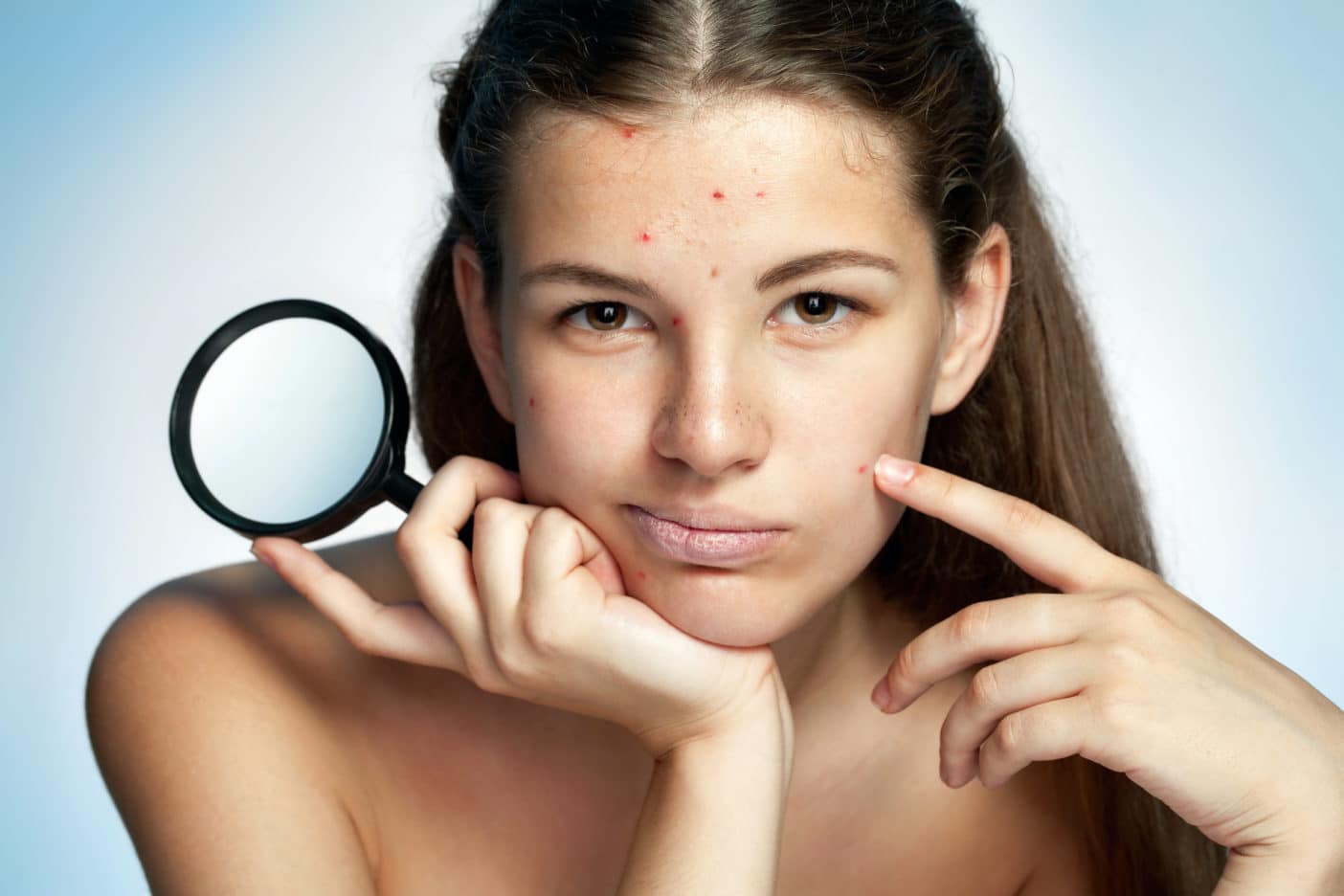Pimples

Pimples, also called comedones in medical jargon, mainly occur in the so-called T-zone, i.e., in the area of the forehead, nose and face, because this is where most sebum is produced. With very oily skin, they can also extend over the entire face and sometimes also on the back or décolleté. Pimples develop when, as a result of excessive cornification, the channel of the sebaceous gland follicles becomes blocked. Sooner or later, the cornification thickens into a tough plug, which then completely closes the exit of the respective follicle channel. Due to the combination of oxygen and the stored pigment melanin, this plug then usually turns dark, it oxidizes. The discolorations are therefore not dirt, as is often assumed. By the way, the typical black spots are open pimples. Closed pimples are white to light yellow and, as the name suggests, closed, because they lie deep under the skin surface. If closed blackheads grow over time, they can become open blackheads.
By the way, the term blackhead was first recorded in a dictionary as early as 1691. It was based on the former assumption that most diseases were caused by parasites or larvae. At that time, people thought blackheads were maggots or worms that, like leeches, sucked on the human body and fed on secretions. Even though this theory has long since been disproved, the term blackhead has remained colloquial to this day.
Pimples: causes and triggers
A hormonal imbalance is the most common cause of pimples. This imbalance is in turn influenced by various factors. Puberty, pregnancy, but also the onset of menopause can promote the formation of pimples in adolescents and adults. Other triggers include stress and hectic activity, anabolic steroid abuse, heavy cigarette or alcohol consumption, and ultimately genetic predisposition. However, a healthy and sensible lifestyle can ensure that fewer or no pimples develop. A diet consisting mainly of fruit, vegetables and whole grains, sufficient sleep and abstinence from alcohol and nicotine: If you follow these simple rules, you will inhibit the formation of pimples. Of course, skin care that is appropriate for the type of skin is also very important. Those who tend to have oily skin should use skin care products that are specially formulated for this skin type.
Pimples: Not all treatment options lead to success
Many sufferers tend to squeeze out pimples themselves. The problem then also seems to be eliminated at first, but dermatologists view this type of self-treatment rather critically. Manual squeezing can also simultaneously push bacteria deeper into the skin, where in the worst case they can trigger severe abscesses. But even in more harmless cases, squeezing out the pimples often leads to inflammation, which later leaves unsightly scars. Nevertheless, of course, no one has to live with the annoying pimples, which are perceived by most people as unaesthetic and unpleasant. Various home remedies are considered secret tips, which are spread from generation to generation and can definitely provide relief in mild cases. However, grandma’s tricks do not offer a guarantee. For example, sodium bicarbonate as a pack or mask is said to be able to fight pimples. A mixture of table salt and water could also be helpful, as it prevents blockages by removing dead skin cells, while also having a bit of a disinfectant effect. Another home remedy is tea tree oil, around which a real hype arose a few years ago. But be careful: Tea tree oil must be carefully dosed, because it dries out the skin strongly.
On many cosmetic preparations against impure skin you can read the note “non-comedogenic”. This means that these preparations do not contain any ingredients that would promote pimples and are therefore recommended.
Effective ingredients against pimples
If you are already fighting pimples, you should only use cosmetics that are labeled “non-comedogenic”.
Triggering and thus comedogenic ingredients mainly include mineral oil products such as kerosene oil, as well as silicone and PEG. Such ingredients are partly also contained in products against impure skin, but since they can promote pimples, they are counterproductive for people who are affected by pimples.
Effective against blackheads, on the other hand, are products with retinoids such as tretinoin, isotretinoin or adapalene. These derivatives of vitamin A have both an anti-inflammatory and comedolytic effect, i.e., they open blackheads and break them down. The same applies to azelaic acid, which is considered very well tolerated and can even be used during pregnancy and breastfeeding. Washing gels or creams with benzoyl peroxide usually help against blackheads as well. This active ingredient not only kills the bacteria on the skin, but also makes the pores less clogged. Salicylic acid also breaks down the oils and fats within the pores, preventing dead skin particles from causing blockages.
Fortunately, pimples do not have to be
Those who pay attention to a healthy lifestyle and do not fight blackheads by squeezing them out themselves, but instead use specially developed products, do not have to put up with the annoying comedones. In addition, the skin should not be cleaned with soap, if possible, but with mild washing lotions, because otherwise the acid mantle of the skin could be destroyed and the sebum production increased.
If you would also like to offer effective cosmetics in this area, please feel free to ask us.
Literature:
Ivanova K, Ramon E, Ivanova A, Sanchez-Gomez S, Tzanov T.Antioxidants (Basel). 2023 Feb 9;12(2):432